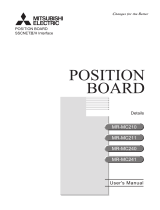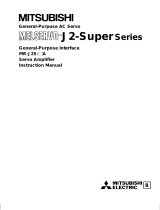
1. FUNCTIONS AND CONFIGURATION
1 - 8
1.3 Standard specifications
1.3.1 Servo amplifier
Model: MR-J4-_-RJ010 10B 20B 40B 60B 70B 100B 200B 350B 500B 700B 11KB 15KB 22KB
Rated voltage 3-phase 170 V AC
Output
Rated current [A] 1.1 1.5 2.8 3.2 5.8 6.0 11.0 17.0 28.0 37.0 68.0 87.0 126.0
Voltage/Frequency
3-phase or 1-phase
200 V AC to 240 V AC, 50 Hz/60 Hz
3-phase 200 V AC to 240 V AC, 50 Hz/60 Hz
Rated current [A] 0.9 1.5 2.6
3.2
(Note
5)
3.8 5.0 10.5 16.0 21.7 28.9 46.0 64.0 95.0
Permissible voltage
fluctuation
3-phase or 1-phase
170 V AC to 264 V AC
3-phase 170 V AC to 264 V AC
Permissible frequency
fluctuation
Within ±5%
Power supply
capacity
[kVA] MR-J4-_B_(-RJ) Servo Amplifier Instruction Manual section 10.2
Main circuit
power supply
input
Inrush current [A] MR-J4-_B_(-RJ) Servo Amplifier Instruction Manual section 10.5
Voltage/Frequency 1-phase 200 V AC to 240 V AC, 50 Hz/60 Hz
Rated current [A] 0.2 0.3
Permissible voltage
fluctuation
1-phase 170 V AC to 264 V AC
Permissible frequency
fluctuation
Within ±5%
Power
consumption
[W] 30 45
Control circuit
power supply
input
Inrush current [A] MR-J4-_B_(-RJ) Servo Amplifier Instruction Manual section 10.5
Voltage 24 V DC ± 10%
Interface power
supply
Current capacity [A] (Note 1) 0.3 (including CN8 connector signals)
Control method Sine-wave PWM control, current control method
Dynamic brake Built-in External option (Note 6)
Communication function USB: connection to a personal computer or others (MR Configurator2-compatible)
Encoder output pulses Compatible (A/B/Z-phase pulse)
Analog monitor 2 channels
Protective functions
Overcurrent shut-off, regenerative overvoltage shut-off, overload shut-off (electronic thermal), servo motor
overheat protection, encoder error protection, regenerative error protection, undervoltage, instantaneous
power failure protection, overspeed protection, and error excessive protection
Safety function STO (IEC/EN 61800-5-2)
Standards certified by CB EN ISO 13849-1 category 3 PL d, IEC 61508 SIL 2, EN 62061 SIL CL 2, and EN 61800-5-2 SIL 2
Response performance 8 ms or less (STO input off → energy shut off)
Safety
performance
(Note 3)
Test pulse input (STO)
Test pulse interval: 1 Hz to 25 Hz
Test pulse off time: Up to 1 ms
CE marking
LVD: EN 61800-5-1
EMC: EN 61800-3
MD: EN ISO 13849-1, EN 61800-5-2, EN 62061
Compliance to
standards
UL standard UL 508C
Structure (IP rating) Natural cooling, open (IP20) Force cooling, open (IP20)
Force cooling, open
(IP20) (Note 4)
Close mounting (Note 2) Possible Impossible
Operation
0 °C to 55 °C (non-freezing)
Ambient
temperature
Storage
-20 °C to 65 °C (non-freezing)
Operation
Ambient
humidity
Storage
90 %RH or less (non-condensing)
Ambience Indoors (no direct sunlight), free from corrosive gas, flammable gas, oil mist, dust, and dirt
Altitude 1000 m or less above sea level
Environment
Vibration resistance 5.9 m/s
2
, at 10 Hz to 55 Hz (directions of X, Y and Z axes)
Mass [kg] 0.8 1.0 1.4 2.1 2.3 4.0 6.2 13.4 18.2
Note 1. 0.3 A is the value applicable when all I/O signals are used. The current capacity can be decreased by reducing the number of
I/O points.
2. When closely mounting the servo amplifier of 3.5 kW or less, operate them at the ambient temperatures of 0 °C to 45 °C or at
75% or smaller effective load ratio.
3. Test pulse is a signal which instantaneously turns off a signal to the servo amplifier at a constant period for external circuit to
self-diagnose.
4. Except for the terminal block.
5. The rated current is 2.9 A when the servo amplifier is used with UL or CSA compliant servo motor.
6. Use an external dynamic brake for this servo amplifier. Failure to do so will cause an accident because the servo motor does
not stop immediately but coasts at emergency stop. Ensure the safety in the entire equipment.

























